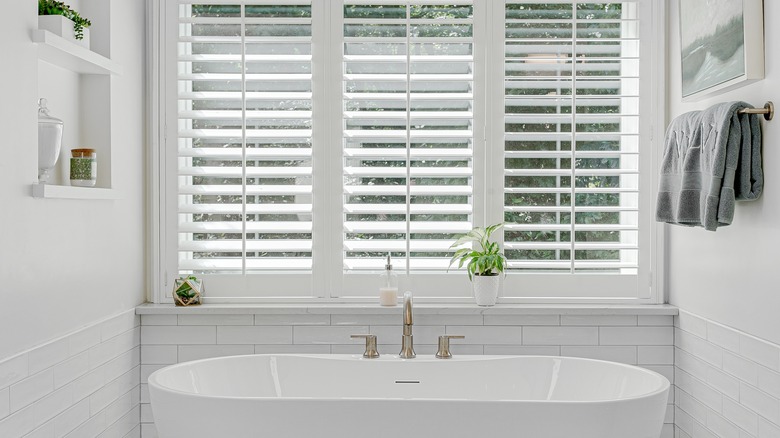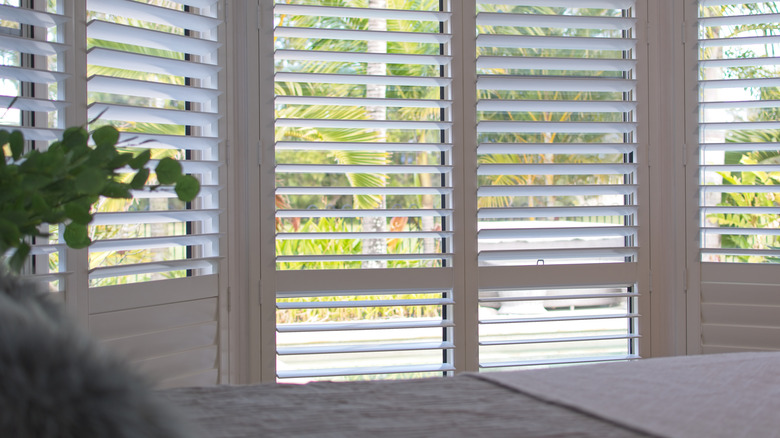Don't Make This Mistake When Cleaning Plantation Shutters
With colonial-style homes, a well-matched shutter can make quite a statement and elevate a home's curb appeal. Simply put, they add a timeless and thoughtful touch. These outdoor shutters are typically made from durable materials such as vinyl, aluminum, or composite wood. These materials are chosen for their ability to withstand outdoor elements like rain, sun, and wind without deteriorating or warping. Like any part of the home, they also require cleaning in order to maintain their elegant façade. Typically, a water-based cleaner is gentle yet effective at removing dirt, grime, and environmental pollutants without causing damage to the material. Water-based cleaners are also less likely to leave behind residue, ensuring a clean and streak-free surface on the shutters. This same approach, however, will not work on most indoor plantation shutters and can actually damage the integrity of the material.
Plantation shutters are a common window treatment type. These coverings consist of adjustable horizontal slats mounted within a frame. They offer privacy, light control, and aesthetic appeal. Typically made from wood, they're also favored for their durability and timeless style. When cleaning wood furniture, it's best to avoid water-based cleaners. Excessive moisture can cause wood shutters to swell, warp, or even rot over time, particularly if the wood isn't properly sealed. Instead, a neutral pH wood cleaner with a 2:1 polish to cleanser ratio is best for wood furniture like plantation shutters, as it effectively cleans and nourishes the wood without stripping its natural oils or causing damage.
How to clean plantation shutters properly
When it comes to tackling dirty plantation shutters, invest in a proper wood cleaner to preserve their natural beauty. Always follow the directions on the product label to ensure you do not damage your shutters. Generally, most oil-based wood cleaners can be applied directly to the furniture. It's always a good idea to start using a product in an inconspicuous place to be sure that it's safe to use on your shutters. Start by dusting the shutters with a soft cloth to thoroughly to remove any loose dirt or debris. Next, apply a small amount of the wood cleaner directly onto a clean, dry cloth. Avoid saturating the cloth with too much cleaner, as this can lead to excess product on the shutters. Gently wipe down each slat with the cloth, working from the top to the bottom. Ensure thorough coverage, especially in areas with visible dirt or grime buildup. Take your time to clean each slat effectively.
For any intricate areas or tight corners, use a soft brush dipped in the wood cleaner to gently scrub away dirt and debris. Be careful not to apply too much pressure to avoid damaging the shutters. After cleaning each slat, use a separate clean and dry cloth to buff away any excess cleaner and moisture from the wood surface. This step helps to prevent streaks and ensures a smooth finish. Once you've cleaned all the shutters, allow them to air dry completely before operating them.
Other maintenance tips for plantation shutters
When it comes to maintaining the elegant appearance of your plantation shutters, there are a few occasional routines you can practice to prolong their beauty. Inspect the hinges and hardware of your indoor plantation shutters periodically to ensure they are in good condition. Loose or damaged hinges can cause the shutters to hang unevenly or swing improperly, affecting their functionality and aesthetics. Tighten any loose screws or replace damaged hardware as needed to keep the shutters operating smoothly. Lubricating the hinges with a silicone-based lubricant can also help prevent squeaking and prolong the life of the hardware. Regular maintenance of the hinges and hardware will help prevent issues and ensure that your indoor plantation shutters continue to function properly for years to come.
Another essential maintenance tip for plantation shutters is to periodically inspect the louvers for any signs of misalignment or damage. Over time, frequent use or accidental impact can cause individual louvers to become misaligned or even break. Inspect the louvers carefully, paying attention to their alignment within the frame and any visible signs of wear or damage. If you notice any issues, such as louvers not closing properly or cracks in the material, address them promptly to prevent further damage and ensure smooth operation. Depending on the severity of the problem, you may need to adjust the tension screws or replace damaged louvers. Regularly inspecting and maintaining the louvers will help extend the lifespan of your plantation shutters.


